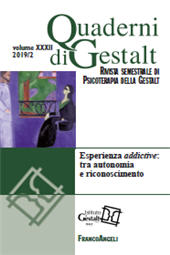Neuroscienze dell'addiction e clinica gestaltica : integrazioni funzionali
33-49 p.
Gli autori delineano il modo in cui le attuali ricerche neuroscientifiche nel campo delle addiction convalidino le intuizioni cliniche della psicoterapia della Gestalt, in particolare per quanto riguarda l'isomorfismo tra le aree cerebrali, subcorticali e non, implicate nella patogenesi di una dipendenza patologica e al contempo determinanti nello sviluppo di competenze relazionali. La possibilità che sin dalle prime relazioni significative il bambino viva esperienze di cocostruzione di un buon confine di contatto, diventa funzione di protezione dall'incontro con esperienze addictive. Un accento particolare viene posto alla condizione dell'adolescente, sempre più sottoposto all'imperativo dell'efficienza ma esposto a quote enormi d'ansia.
In terapia non lavoriamo per contrastare la potente figura dell'oggetto di dipendenza ma sullo sfondo dell'esperienza per rivitalizzare il sé, fornire ground e genuino riconoscimento. La danza tra terapeuta e paziente, l'attenzione alla persona nella sua globalità, lo sguardo estetico e fenomenologico del terapeuta appaiono strumenti efficaci per un lavoro terapeutico che modifica, in senso esistenziale, lo sfondo dell'esperienza dell'addicted nel rapporto con sé e il mondo e, sul piano neurofisiologico, le aree cerebrali disconnesse dall'esperienza addictive, in senso reintegrativo. [Testo dell'editore].
The authors describe the relationship between recent neuroscientific researches on addiction (cfr. Robinson e Berridge, 1993; Leshner, 1997; Volkow e Fowler, 2000; Goldstein, 2001; Goldstein e Volkow 2002; Gessa, 2003; McFarland et al., 2003; Pulvirenti, 2007; Bricolo et al., 2010) and clinical insights of Gestalt therapy on this topic; in particular they refer to isomorphism of some brain areas (subcortical and superior) involved both in the addiction pathogenesis and in the development of relational skills. The authors describe Perls' reflections (1995) on "hanging on bite", the recent reflections of other Gestalt authors (Pintus e Crolle Santi, 2014; Pintus, 2015; 2016; 2017) on the dependent relationship style, the value of the first parent-child relationships as an opportunity for relational and cerebral attunement and describe the processes and areas of the brains involved in these phenomena.
The addiction development is an experience of persistent background trauma, a dissociation between cognitive and emotional brain areas. If the child feels supported in the first significant relationships to live a spontaneous contact boundary then a good attunement and recognition are created. On the contrary the relational detuning causes less development of the mesolimbic area and deficit in the decoding of emotions. These children could develop a specific vulnerability to become fragile and insecure adults. The authors emphasize the adolescent condition: he is pushed more and more towards efficiency but often he feels enormous anxiety. The desensitization, caused by substances, is often an opportunity for the adolescent who, confused between who he was and who he would like to be, finds a label for his pain.
The Gestalt therapist does not work against the addiction powerful figure, he works with the background experience of the client: in pathological dependences the obsession for the loved object becomes so intense, so capable of nullifying the background experience, that in therapy it is necessary to work creatively to revitalize it. Therefore the main therapy goal is not abstinence but to revitalize the self, provide basic and genuine recognition. The living and real presence of a significant Other on the contact boundary can become an opportunity for the addict to reconstruct his dysfunctional attachment tale; unlike an object, immovable and immutable, the living presence of the therapist can become an opportunity to realize the intentionality of interrupted contact.
Concepts such as contact boundary, situational field, aesthetic relational knowledge (Spagnuolo Lobb, 2015) represent a possible bridge towards neuroscience, particularly for understanding the mind, the brain and the relational styles of an addictive client. The dance between therapist and client (Spagnuolo Lobb, 2017), attention to the person as a whole, the aesthetic and phenomenological gaze of the therapist (Spagnuolo Lobb, 2012; 2015) are effective tools for a Gestalt therapeutic work. These tools modify, in an existential way, the background of the experience of the addicted person in the relationship with himself and the world; but they are able, in a neurophysiological sense, also to activate a new integration between cognitive and emotional areas of the brain that had been disconnected from the trauma of addiction. [Publisher's text].
-
Artikel aus derselben Ausgabe (einzeln erhältlich)
-
Informationen
ISSN: 2035-6994
THEMENBEREICHE
KEYWORDS
- Addiction, neuroscienze, adolescenza, vulnerabilità, esperienza di riconoscimento
- Addiction, neuroscience, adolescence, vulnerability, recognition experience



